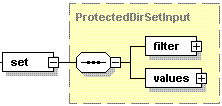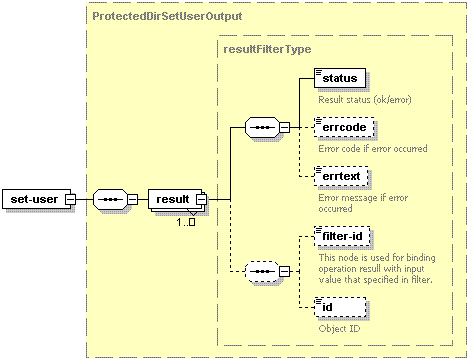Changing Protected Directory User Settings
Use the set-user operation to change settings of the protected directory user.
Request Packet Structure
A request XML packet changing protected directory user settings includes the set-user operation node:
<packet>
<protected-dir>
<set-user>
...
</set-user>
</protected-dir>
</packet>
The set-user node is presented by type ProtectedDirSetInput
(protected_dir.xsd), and its graphical representation is as follows:

Note: The interactive schema navigator for all request packets is available here: http://plesk.github.io/api-schemas/1.6.8.0/agent_input.svg.
-
The filter node is required. It specifies the filtering rule. For details, refer to the Available Filters section. Data type: ProtectedDirUserFilter (
protected_dir.xsd). -
The values node is required. It specifies the protected directory name. The node is presented by type ProtectedDirUser (
protected_dir.xsd). Its graphical representation is as follows: -
The login node is optional. It specifies the protected directory user login. Data type: string.
-
The password node is optional. It specifies the protected directory user password. Data type: string.
-
The password-type node is optional. It specifies the protected directory user password type. Data type: string. Allowed values: plain | crypt.
Note: When creating request packets, put nodes and elements in the order they follow in the packet structure.
Response Packet Structure
The set-user node of the output XML packet is presented by type
ProtectedDirSetUserOutput (protected_dir.xsd) and structured as
follows:

Note: The interactive schema navigator for all response packets is available here: http://plesk.github.io/api-schemas/1.6.8.0/agent_output.svg.
- The result node is required. It wraps the response retrieved
from the server. Data type: resultFilterType (
common.xsd). - The status node is required. It specifies the execution status of the operation. Data type: string. Allowed values: ok | error.
- The errcode node is optional. Is returns the error code if the operation fails. Data type: integer.
- The errtext node is optional. It returns the error message if the operation fails. Data type: string.
- The filter-id node is required if the request packet is valid . It returns the filtering rule parameter. For details, refer to the Available Filters section. Data type: anySimple.
- The id node is required if the operation succeeds . It returns the ID of the protected directory user whose settings were changed. Data type: integer.
Samples
Changing preferences of a single protected directory user
The packet that changes preferences of a protected directory user with ID 1 looks as follows:
<packet>
<protected-dir>
<set-user>
<filter>
<id>1</id>
</filter>
<values>
<password>qweqwe</password>
<password-type>plain</password-type>
</values>
</set-user>
</protected-dir>
</packet>
Response:
<packet>
<protected-dir>
<set-user>
<result>
<status>ok</status>
<filter-id>1</filter-id>
<id>1</id>
</result>
</set-user>
</protected-dir>
</packet>
If the user was not found, the response from the server looks as follows:
<packet>
<protected-dir>
<set-user>
<result>
<status>error</status>
<errcode>1013</errcode>
<errtext>User is not found</errtext>
<filter-id>12</filter-id>
</result>
</set-user>
</protected-dir>
</packet>
If no password was specified in the request packet, the response from the server looks as follows:
<packet>
<protected-dir>
<set-user>
<result>
<status>error</status>
<errcode>1019</errcode>
<errtext>Invalid value for 'password' specified</errtext>
<filter-id>12</filter-id>
</result>
</set-user>
</protected-dir>
</packet>
Changing preferences of multiple protected directory users
The packet that changes preferences of all users of the protected directory with ID 1 looks as follows:
<packet>
<protected-dir>
<set-user>
<filter>
<pd-id>1</pd-id>
</filter>
<values>
<password>qweqwe</password>
<password-type>plain</password-type>
</values>
</set-user>
</protected-dir>
</packet>
Response:
<packet>
<protected-dir>
<set-user>
<result>
<status>ok</status>
<filter-id>1</filter-id>
<id>13</id>
</result>
<result>
<status>ok</status>
<filter-id>1</filter-id>
<id>14</id>
</result>
</set-user>
</protected-dir>
</packet>
